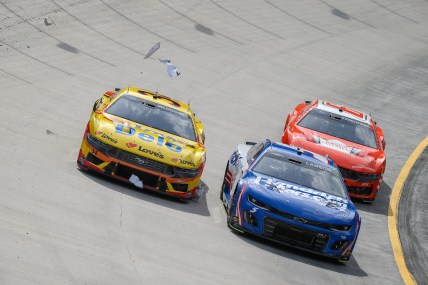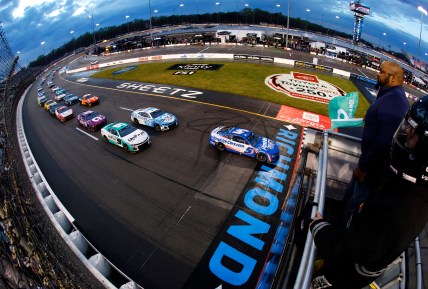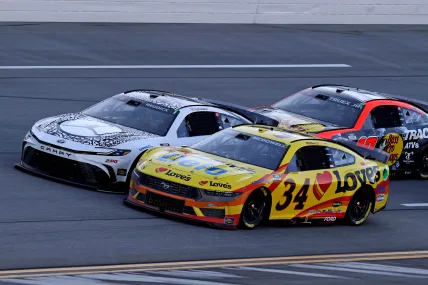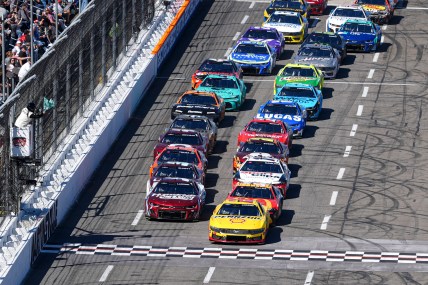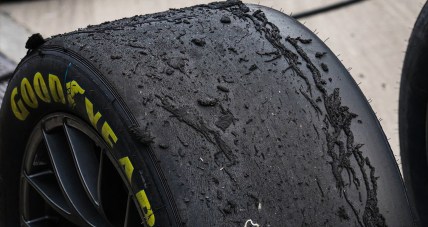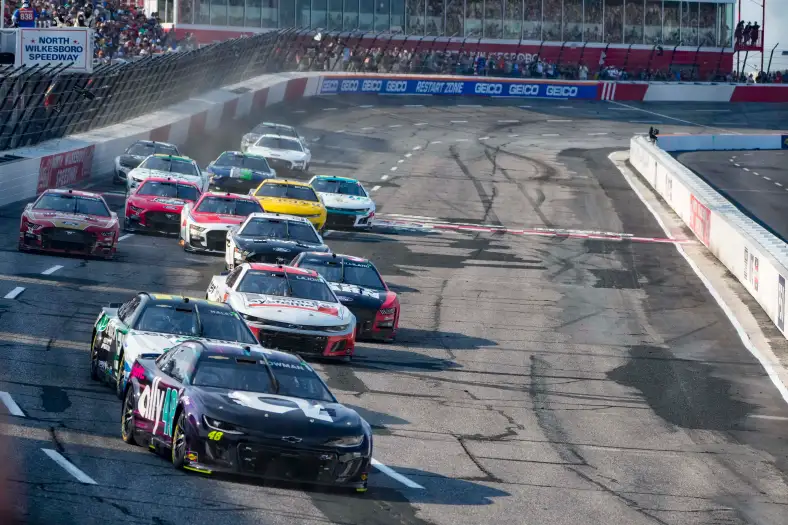
The Cup Series race in March at Bristol Motor Speedway was described as a ‘happy little accident’ and history might remember it as a catalyst that could change the course of short track racing with the NextGen car.
In real time, Goodyear executives were distraught because the race did not match internal projections or the recommendations it issued to teams in advance of the weekend. Greg Stucker, the company director of racing, called a media scrum just to get ahead of any potential bad press.
But as it turns out, the teams and fans largely agreed it produced one of the best races in recent memory and provided a clear direction for NASCAR and Goodyear to pursue for future short track events.
That, combined with lessons learned from the wet weather tire segments at North Wilkesboro last year and at Richmond earlier in the month, inspired what the Cup Series will experiment with next month in the All Star Race.
An option tire.
The short version, which has been detailed in full here, is that the feature race will begin on a softer alternative tire modeled after the wet weather compound but will need to switch back and forth over 200 laps with a standard short track tire on the newly repaved surface at Wilkesboro.
The option tire could produce up to a half-second faster lap time but at the expense of lap time fall off over the course of 30-50 laps.
Basically, with a repaved track creating a single groove and considerably less tire wear, Goodyear and NASCAR is hoping to create multiple strategic options and lap time disparity via decisions made atop the pit box and what drivers do with their throttle input.
It was all inspired by what happened at Bristol.
“It was huge,” Stucker said on Wednesday during an appearance on SiriusXM NASCAR Radio. “We’ve heard drivers talk about wanting tire falloff because it adds to the quality of racing and creates comers and goers.
“I agree with that but the tire falloff has to be something drivers can influence. That’s exactly what we saw at Bristol with tires wearing as fast as they did. The race became the ultimate in tire management.
“Some guys did a better job than others and their right feet could have an impact on the racing, lap times and creating the amount of passing we saw throughout the race.”
To a lesser extent, the same dynamic proved true during the heat races at Wilkesboro last year and at the start of the race at Richmond, which began on wet weather tires that faded quickly once the track began to dry.
Driving styles created a tremendous amount of passing, lap time deviation and contact on the race track.
Thus Stucker and NASCAR officials are working towards a way of creating a version of that type of racing on short tracks, but in dry conditions.
“A rain tire is designed to run in those cool wet conditions we have when its wet,” Stucker said. “It’s formulated with the oils, the resin and the carbons we use and the levels of each to generate heat in those kinds of conditions.
“When you run into the dry conditions, then the tire will generate more heat and more wear and that’s what leads to the falloff.
“So again, tire management becomes key and we saw that at Richmond. That’s what the drivers have been telling us they want with the short track package, something they have to manage and we saw that in the first segment at Richmond.”
So they tested a dry tire that replicated the wet weather compound but on a slick instead of treads. Stucker says it went well.
“It performed the way we expected,” he said. “It was faster. Three to four tenths per lap than the prime but it fell off dramatically and quite a bit faster than the prime did.
“When we started having discussions with NASCAR about the potential of an option tire at the All Star Race, this seemed like the perfect fit. It’s not about the fact that its faster, it is faster for a while so that’s the benefit but then you have to manage it to get to 35, 40 and 50 laps. It’s about risk and reward and the All Star Race is the perfect place for that.”
Stucker and NASCAR’s senior vice president of competition, Elton Saywer, also said the decision was made to force teams to start the race on the option tire so that everyone would immediately have to go into their various conservation approaches since the first scheduled caution isn’t until Lap 100.
“We want to make sure we put the teams and drivers, that as soon as they start the race, they have to manage the tire,” Sawyer said earlier in the day on the same station.
“From that point on, they’ll have two sets of options and two sets of the prime tires to get through the event. We’ll have stops at lap 100, and they will have to execute a four-tire stop, and which tires they put on will be up to them.
“Lap 150, they can stay out, they can pit, they can put on primes, they can put on options .. and fortunate or unfortunately, if we get any rain, we still have the wet weather tire too.”
The All Star Race has long been a testing ground for numerous NASCAR competition elements that have made its way into regular season competition like stage racing and double file restarts.
If the short track option tire proves successful, that too could make its way into the regular season conversation.
“We view the All Star Race as a real opportunity to learn further,” Stucker said. “Bristol wasn’t a very pleasant day because of the unexpected — that tires wore a lot faster than what we expected them to coming into the weekend.
“But we learned from it. We learned that fans enjoyed the racing and we’re going to try to build upon that, learn from this All Star Race, and see if it changes our approach.
“Maybe an option tire is something we carry forward. We’re not committed to that and neither is NASCAR but I think it’s certainly something on the table because our commitment is doing what we can to help the racing.”
What happened at Bristol?
Stucker also said Goodyear has largely concluded its investigation into what created the extreme tire wear at Bristol in March.
“The race track was different and it behaved differently. Think about the spring race at Bristol the past three years and it was on dirt. The track sat covered in dirt over the winter months, we race on the dirt, it gets uncovered and cleaned and then there are other races before we hit the track in the fall.
“We ran the same package, and didn’t see the wear we saw in the spring. I think it was simply the conditions of the track being green at the time … no racing before we got there for the weekend. I think the resin instead of the PJ1 contributed to it. It was a number of factors that created the wear, unexpected, higher than expected, but at the same time, created a different style of racing where tire management was extremely important.”
Matt Weaver is a Motorsports Insider for Sportsnaut. Follow him on Twitter.
